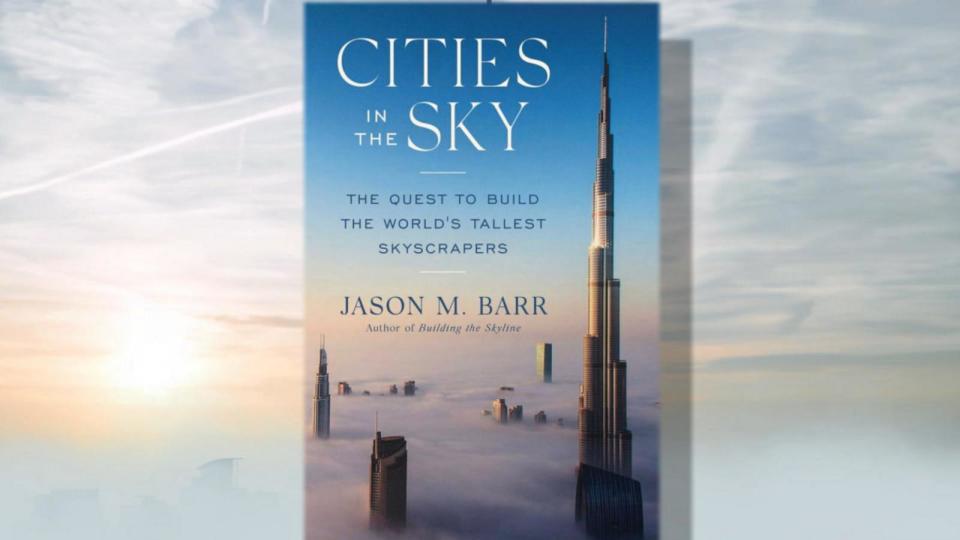Global quest for taller and taller buildings driven by urban future, author says
- Oops!Something went wrong.Please try again later.
Growing up in Long Island, New York, 54 miles from Manhattan, Jason Barr became fascinated by the city's skyscrapers. Due to his fascination, he started researching how skyscrapers are built and the economics behind the soaring buildings.
Barr, author of the new book "Cities in the Sky: The Quest to Build the World's Tallest Skyscrapers," says that the popularity of people wanting to live in a city will cause more tall buildings to help it grow. He also mentioned significant technological advancements have made it easier to construct taller buildings.

ABC News sat down with Barr to discuss the changing role of skyscrapers, transitioning from corporate spaces to mixed-use developments that include residential, retail and recreational areas.
ABC NEWS LIVE: Skyscrapers have become iconic symbols of the heights of human achievement. In his new book, "Cities in the Sky: The Quest to Build the World's Tallest Skyscrapers," professor, researcher and author Jason M. Barr explores the ever-growing global quest for super tall buildings.
Thank you, Mr. Barr, for joining us tonight. "Cities in the Sky" explores the world of skyscrapers. What about skyscrapers fascinated you so much that you decided, you know, 'I'm going to write a book about this'?
JASON BARR: I grew up on Long Island, and Manhattan, to me, was always so fascinating. So when I became a professor at Rutgers University in Newark, I decided why not do research on the Manhattan skyline. And that's how I got started. And that was in 2005. And I've been working on economics to skyscrapers ever since. And this book just explores what's happening around the world beyond New York City.
ABC NEWS LIVE: And you write: 'When we look around the world, we see the skyscrapers are steadily sprouting upward, even as economics, politics, city patterns, and technology change.' What do you believe drives the pursuit of constructing taller buildings?
BARR: Well, I would say that fundamentally it's urbanization. People are moving to cities. People are working in cities. People are playing in cities. And around the world, cities are more important than ever. And so, really, at the heart of it, tall buildings are just a way to help cities grow. And also, there's just massive improvements in technology that make building taller and taller easier and easier. So it's really the combined forces of both the desire to be in cities, along with the, technology that makes it easier to make these buildings tall.
ABC NEWS LIVE: Throughout the book, you discuss the evolving role of skyscrapers, from corporate spaces to mixed-use developments incorporating residential, retail, and recreational areas. Talk about how these skyscraper complexes reflect our changing society.
BARR: Well, in the early days, take the Empire State Building, for example. That was predominantly an office building. Today, super tall skyscrapers, for example, like the Burj Khalifa, are mixed-use buildings. So you have malls on the ground floors, offices above that, residential and hotels above that.
And then you have observatories. Observatories are huge moneymakers. People just love to go up and view the city and the skylines from 1,000 feet in the air. So they definitely reflect our changing society in the sense that they're much more, multi-purpose than they were before. And it just reflects the changing nature of what we do in cities.
ABC NEWS LIVE: You write about so many of the world's tallest buildings. Do you have a favorite?
BARR: My favorite is the Empire State Building. It's just a classic building. Also, like I said, to me, the skyscraper really started in New York City, and it was the world's tallest building for 40 years. And that ambition, and that to make the world's tallest building just represents New York. It's just an elegant building.
It's just the, just the way the, the spire is lit up at night. It just just makes me proud to say, you know, I'm from New York, and the Empire State Building represents, what I think is the greatest city on the Earth.
ABC NEWS LIVE: We could tell just how your eyes light up talking about it. Do you believe that this is our future, creating these sky-high buildings?
BARR: I do. And again, because the future is an urban future. And as long as people want to live, work and play in cities, there'll always be a demand for tall buildings.
But people, they tend to focus on, the grandiosity, I'd say, or maybe some of the ego element of the developers. But the truth is that without the demand and the desire to be in cities, you wouldn't have any of these tall buildings. Some are over the top, of course. But I think that just cities are places where people are striving to, to make it. And, as long as there's striving, as long as there's a desire to be in cities, there will be tall buildings.
ABC NEWS LIVE: Over the top. I guess that's the point, right? No pun intended.
BARR: Oh, yeah. No. Advertising? Absolutely. Advertising is a big thing. Also these buildings, they increase the, dramatically, the the value of the properties surrounding it. So many apartment buildings that have view of these super-tall buildings, they just they rent or sell for more.
So the spillover benefits to the neighboring properties and communities are enormous. And so, it really gives people, these really tall buildings that give people a pride of place. And it's something that people love viewing, both from the observatory and from the ground up.
ABC NEWS LIVE: Jason, we thank you so much for joining us. "Cities in the Sky: The Quest to Build the World's Tallest Skyscrapers" is now available wherever books are sold.
Global quest for taller and taller buildings driven by urban future, author says originally appeared on abcnews.go.com

